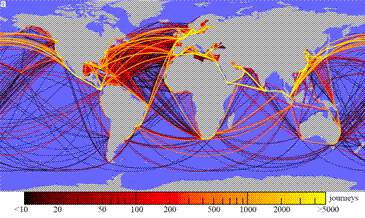Mapping the Global Shipping Network
Surprisingly, the global shipping network has never been mapped, despite estimates that 90% of the world's trade travels across the oceans. Now, a group of researchers from Germany have published a network analysis of global shipping routes based on data from 2007: The complex network of global cargo ship movements.
The maritime network shows some surprising differences from the network that flight paths make between airports. For example, on average, it takes just 2.5 jumps to move from one port to another on the maritime network compared to an average of 4.4 to move between one airport and another. The maximum shortest path between ports is 8 jumps while between airports it is 15 jumps. It looks to be decidedly easier to travel the world by ship than by plane, at least in some respects.
One oddity, however, is that the maritime network is decidedly asymmetric: more than half of all ports are linked in only one direction, meaning that cargo ships do not routinely make round trip journeys between ports.

In this image of global production and consumption patterns, the heavily trafficked passage through the Suez Canal and North Africa really stands out. It's a hugely significant link in the network, and very much in dispute.